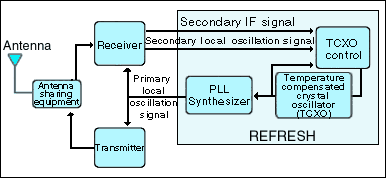Antennas, Base and Mobile Stations -18.Interference Reduction Technology
The mobile communications system uses adaptive transmission power control to decrease voice-channel interference and reduce power consumption. The base station measures the signal level transmitted from the mobile unit during a call, and instructs the mobile unit by control signals to reduce transmission power so that no more than the necessary power is emitted.
Similarly, the mobile unit also measures the signal level transmitted from the base station, and controls the transmission power of the base station by issuing control signals to the base station. In case of a large-capacity NTT system, for example, this reduces the value of the desired to undesired signal ratio for the overall zone by 1 dB to 2 dB.
NTT DOCOMO adopted a reception wave standard correction synthesizer known as REFRESH at the time the Mova was developed. While the frequency stability of the small TCXO that can be mounted on the portable unit has a limit of about 1.5 ppm, frequency stability can be substantially improved from 3 ppm to 0.3 ppm by correcting the oscillation frequency of the portable-unit TCXO on the basis of transmission signals from the base station. Such frequency stability improvements are useful in reducing interchannel interference.

Schematic Diagram of the Received Signal Frequency Stabilized Synthesizer (REFRESH)
![]() Created 1999/03
Created 1999/03
